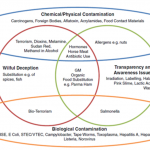It is safe to say that 2020 was a year unlike any other. The COVID-19 pandemic brought on significant changes to everyday life across the world. It also brought some significant challenges to businesses from retail, to restaurants and manufacturing. The supply chain industry faced a challenge like no other when shutdowns began and manufacturers were left scrambling to come up with a backup plan. Although these challenges were tough to handle, it gave the industry a much-needed eye opening to make the changes needed in order to avoid this from happening again.
The food manufacturing industry was hit particularly hard and required some intervention from the U.S. government. In order to protect food plant workers, the FDA and OSHA jointly issued a 16-page checklist for use by owners and operators of food production companies in mid-August. While it did not list any new regulations, it pulled existing guidance from the FDA, CDC, and OSHA. The main focus was on employee health and food safety. The main concern was offering guidance on how to deal with resuming operations, protecting healthy workers, as well as for dealing with sick employees and those exposed to them. One of the struggles we have is that the guidelines relate to how workers behave inside a plant.
These guidelines were just the tip of the iceberg as it forced the industry to take a deeper look into two main areas: Supply chain robustness, visibility and transparency, and traceability. Highly optimized modern supply chains depend on a high degree of predictability from all actors in the chain; they are lean in order to minimize costs and working capital.
Unfortunately, this optimization has made supply chains brittle—the models did not anticipate COVID-19 and the unexpected complexity that followed. Moving forward, manufacturers need to take a closer look at how this happened.
The traditional way to increase robustness in a supply chain is to increase inventory buffers so that any breakdowns can be smoothed out over time. Inventory buffers are expensive, tie up working capital, and increase risks, because a manufacturer may not be able to sell what they have in inventory. A more modern approach is to make supply chains more agile, so changes can be implemented quickly in case the unexpected happens. Agility requires visibility and transparency in order to understand what’s happening. The struggle in manufacturing is that agility must be combined with repeatability so that quality products can be created in a cost-effective way on a large scale. Repeatability also requires visibility and transparency. A famous quote from Lord Kelvin says, “you cannot improve what you cannot measure”. This rings as true today as it did more than 100 years ago. Another key element is repeatability to ensure that the manufacturing resources produce the requested production orders. This is why it is so important to provide transparency in what is going on in your supply chain to ensure processes are stable and repeatable.
The pandemic has brought a renewed focus for manufacturers in making sure they are becoming more transparent and agile within their supply chain processes. They are realizing thanks to this disruption that suppliers can’t always deliver and a backup plan is crucial to keep things moving. One option is to implement technology that helps track visibility and transparency to better assess what is needed and to offer alternative suppliers. Having supply chain transparency requires companies to know what is happening upstream in the supply chain and communicate this knowledge both internally and externally.
Automation Can Help with Supply Chain Visibility
Automation has wrongly been perceived as just a way to kill jobs. At the same time, the idea of “bringing manufacturing back to the United States” is less about bringing jobs back and more about adding value creation. For manufacturers to be effective today, they must automate. It’s not just about being efficient, it’s about enabling manufacturers to scale up with precision. Most importantly, it’s about survival. In order for manufacturers to survive, they need to automate. This is driving a much higher demand in sensors which play an essential role in automation.
Automation systems are unbiased, and don’t have bad day. This means manufacturers can operate with high levels of repeatability and precision. Without this level of automated precision, we would not be able to enjoy many of modern life’s necessities like the car you drive or the cell phone in your pocket.
Additionally, automation reduces errors, increases the efficiency of the labor, and results in higher output with lower labor costs. This helps manufacturers reduce waste, increase sustainability, lower their carbon footprint, and reduce their energy dependency.
2020 prompted many necessary changes to the food manufacturing industry and their interaction with suppliers. It is true that a crisis spurs innovation. The pandemic has forced manufacturers to think differently about how they are conducting business. One thing will be critical to move forward: The ability to have better visibility of your supply chain. Adding visibility, transparency and collaboration tools are going to bring on lasting changes that are to manage a disruption such as a future pandemic.







